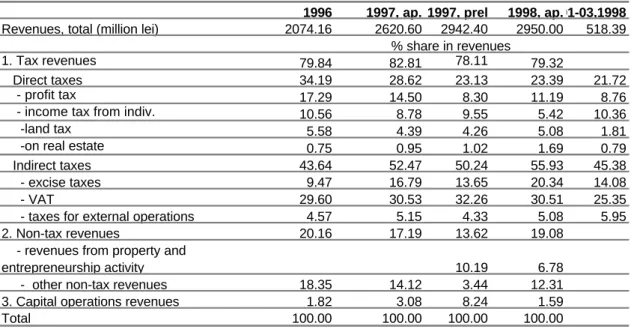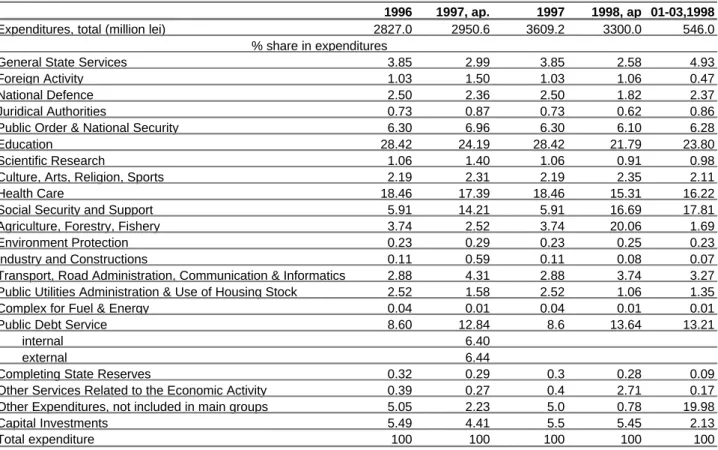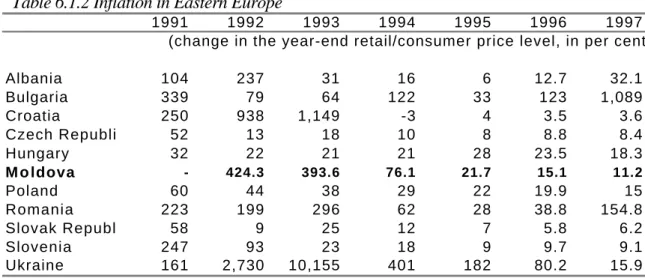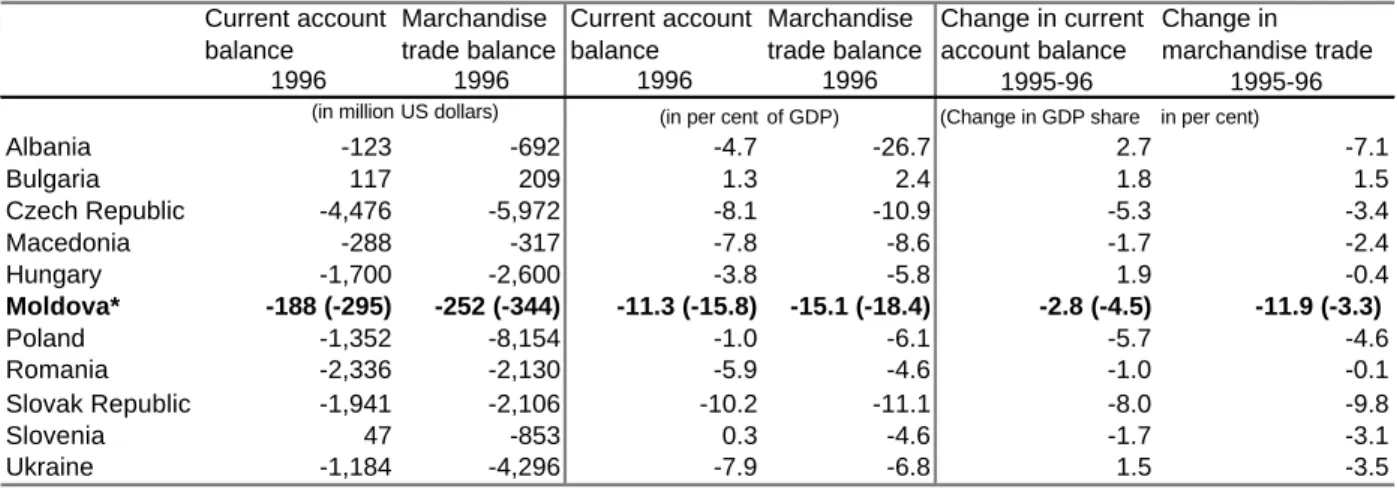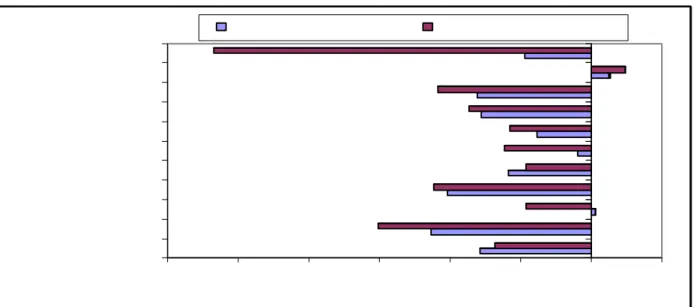The first edition of the Economic Survey: Moldova in Transition, submitted to your attention, has been conceived by its authors as a research monitoring (analysis-forecast) publication of the national economy. Economic Survey aims to fill the almost empty niche - between the passionate materials of the Institute for Statistical and Sociological Analysis and actively emotional publications in mass media.
SOCIAL ECONOMIC OVERVIEW
China, 1996; Social and Economic Development Strategy of the Republic of Moldova during the period until the year 2000; In particular, it means the state regulatory system of the strategic development of the country's economy.
MACROECONOMIC TENDENCIES
Budget and fiscal policy
The following table shows the general picture of changes in the consolidated budget excluding Transnistria). Released in the first half of the year, it may increase expenses by 20%.

Monetary policy, country’s external position, and banking system
This situation improved towards the end of 1997, as the graph below clearly shows, due to the lowering of interest rates on treasury bills. The situation in the banking system of Moldova (22 commercial banks) can be generally assessed as positive.
Investment
A financial investor would typically invest in a potential underperforming company, seek to achieve long-term appreciation of its market value, and transfer shares in the company to a strategic investor. WNISEF is offering various technical assistance programs at no cost to the company to help the management team achieve its objectives. It creates transparency on the company's finances and helps management learn the modern way of running an enterprise.
But the most important thing is the personal involvement of WNISEF staff in the company's activities and strategic decisions. WNISEF's main goal is to help the company become a leader in the region and/or in its field. ADC is currently implementing a management information system which will enable the company to prepare IAS accounts in 1998.
External trade
Changes in the average prices of basic types of exported products in the first 4 months of 1998 compared to the same period of the previous year are shown in the figure. In the first quarter of 1998, the export of goods produced in Moldova (excluding re-exports) decreased by 7.6% compared to the corresponding period of the previous year, in 4 months the volume of exports remained below. A stabilization of the trade balance deficit is evident, although its absolute value still remains very large (see figure).
Underdeveloped tourism, trade, poor quality and expensive services in transportation, communications and information technology caused a deficit in the trade balance of the United States. And this is why the current account deficit does not always reflect an unfavorable position of the country's economy. The figure shows a comparison of the share of foreign direct investment in the total volume of loans in terms of different countries.
ENTERPRISES’ SECTOR: STRUCTURAL REFORMS
Industrial policy and enterprise restructuring
The delay in the implementation of the legislation on the privatization and sale of the land among the industrial enterprises. The production is delivered without payment based on the indications of the respective Ministries. The Regulations on the Dutch Auctions do not allow the commercialization of the assets of the state enterprises.
At the beginning of 1998, companies in the pilot project (Stejaur, Spectrul, Farmaco, Nistru, Flamingo, MFC, Zorile, Piele, Moldagrotehnica, Tricon, Incomaº, Bãlþeanca) have achieved the following achievements. The net result is an increase of 2.6 times compared to the previous year's results. State aid for business restructuring is carried out through the notes of the creditor's board.
Energy sector: restructuring and preparation for privatization
Approval of the debt restructuring plan of the energy sector (Government Decision No. 547 of. The result is the improvement of the operation of energy companies, energy supply and collection of payments for consumed energy. Approval of additional measures for monitoring debts and improving of the financial condition of companies from the energy sector (Government Decision no. 325 of
Detailed examination of the deliveries and collections in the energetic enterprises, including the trends of the exchange operations;. It is proposed to include the investment plans of the distribution companies in the tender documents. Decision on the Privatization Concept of the companies from the energy sector (was approved by the Government by Decision no. 260 from March.
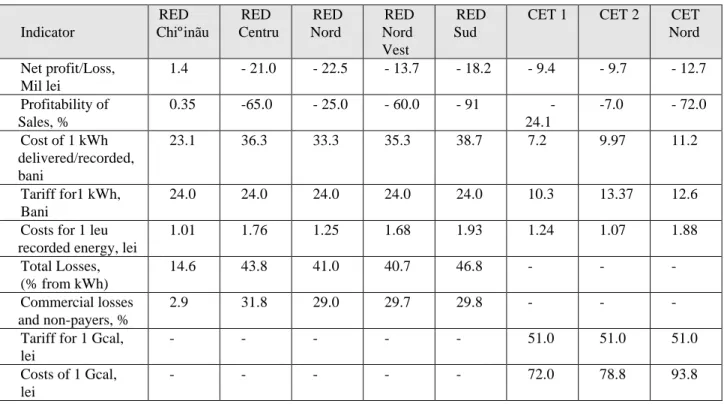
Land reform and farm restructuring
2 Privatization rate is the ratio of the number of individuals who received a physical plot to the total number of individuals. Thus, in 1997 state farms controlled almost 1% of agricultural land, collectives 15% and the new corporate farms controlled 46% of total agricultural land. The efforts of the state to support the large-scale unrestructured enterprises by granting technical credits were not effective.
Meanwhile, agricultural contributions to the budget income constitute only 14% of the total, which is half of the share of the sector in GDP. According to the consolidated balance sheet, the total liabilities of large farms at the end of 1997 were 2.2 billion lei. The total debt of the agro-processing industry in the amount of 0.5 billion lei appears much smaller compared to that of primary agriculture.
Privatization and private sector development
The immediate effect of the above legal provisions was negative for the state budget, as agricultural companies chose a "wait and see" strategy and stopped paying even current taxes to the state and local budgets. The creation of the process of privatization of these individual companies, which must be approved by the parliament, has begun. Therefore, the productivity of the private sector is even lower than that of the state.
The purpose of at least half of the revenues from the privatization of public assets for the restructuring and further modernization of the privatized companies; A common characteristic of post-socialist countries is the slide of the private sector, as well as the state sector, into the gray economy. In the Transition Report -1997 of the EBRD, it is mentioned that if the share of the private sector dominates in the countries of Eastern Europe and the Baltic States, the share of the underground sector dominates in the NIS, which includes to a large extent a.
Shadow economy
The preparation for the accession of the Republic of Moldova to the WTO has been completed. Therefore, the conclusions of the Ricardian theory will not be valid in the case of Moldova. Probably, one of the causes of tax evasion phenomenon spread is the lack of interest of the local authorities to fight it.
For the numerical evaluation of the degree of tax evasion benefit a notion of "tax evasion efficiency". For reducing the phenomenon of tax evasion, the choice of the type of control regime is important. Emergence of the state authority in public opinion can serve as a cheaper way to fight tax evasion.
SOCIAL DEVELOPMENT
This index suggests that the population's incomes and expenditures are very unequally distributed. In mid-1998, the social obligations deficit (the difference between promises and current incomes) amounted to 43% of GDP. The structure of social costs shows that the largest share is accounted for by pensions (15%), followed by education (9.7%) and health care (almost 6%).
Other sectors of the social sphere (culture, social assistance and sport) usually represent slightly less than 6% of GDP. A vulnerable point in the operation of the social protection system is its financial sustainability, which is almost Therefore, children should be at the center of social assistance efforts.
REGIONAL DEVELOPMENT: A CASE OF TRANSNISTRIA
The role of the TRB was strengthened and a concerted effort was made to establish its control over the monetary and credit situation in the region. Measured by most comparators, these difficulties are considerably greater than those faced by the rest of the country. These arrears have actually become a massive subsidy to the economy of the region and a great responsibility for the future.
Agricultural output also declined at a faster rate than in the rest of the country. In 1995-96, average wages were about 20 percent below the average for the rest of the country. To achieve this, much greater efforts are needed on the part of the Transnistrian authorities, especially in the area of macroeconomic stabilization.
ANNEXES
Selective indicators of countries in transition
Here, the term "private companies" refers to all companies in which a majority of the shares are owned by private individuals or entities. The coarseness of the EBRD estimates reflects data limitations, particularly with regard to the scale of informal activities. This is in most cases because the definition of the EBRD concept differs from that of the official estimates.
In recent years, most Eastern European countries have recorded a growing trade deficit and a continuous deterioration of their current accounts. Change in current account balance. in million US dollars) (as a percentage of GDP) (Change in percentage of GDP as a percentage). As for Moldova, the FDI inflow is registering one of the lowest values in the CIS countries and Eastern Europe.
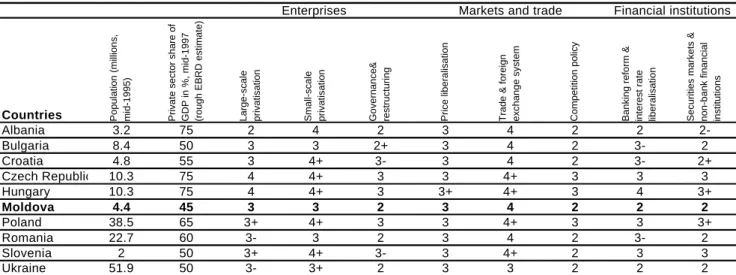
Neighboring countries: Romania and Ukraine
This decrease caused a decrease in domestic demand by 8.5 percent compared to last year and final consumption by 6.4 percent. At the end of 1997, stocks of final products reached 58.5 percent of total production in December. Commercial services decreased in real terms by 19 percent, the share of the private sector in services reached 67.1 percent.
The degree of privatization (according to the social capital criteria) reached 100 percent in textiles in 1997, 90 percent – food. Foreign debt reached 24 percent of GDP in 1997 (for comparison, in the Republic of Moldova – 64 percent). Public budget revenues will amount to 29.5 percent of GDP, expenditures - 33.5 percent of GDP, and the state budget deficit - 3.6 percent of GDP.

